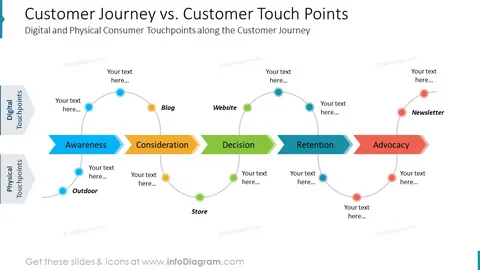Understanding the Digital Customer Journey in a Multi-Channel World

The digital customer journey has transformed dramatically in today’s interconnected, multi-channel landscape. Consumers no longer follow a predictable path from discovery to purchase; instead, they navigate a complex web of touchpoints across devices, platforms, and environments. From social media ads to in-store experiences, each interaction shapes their perception and decision-making process. For businesses, mastering this journey means understanding how customers move seamlessly—or sometimes not so seamlessly—across channels, and strategically optimizing every step to foster engagement and loyalty. This article delves into the nuances of the digital customer journey in a multi-channel world, exploring its stages, challenges, and strategies for success.
The Evolving Landscape of Customer Interactions
In a multi-channel world, customers engage with brands through an array of platforms: websites, mobile apps, social media, email, physical stores, and even emerging technologies like voice assistants. This diversity creates both opportunities and complexities. A customer might discover a product through a targeted Instagram ad, research it on a brand’s website via their laptop, and ultimately make a purchase in a physical store after receiving a promotional email. Each channel plays a distinct role, yet they must work cohesively to create a unified experience.
The shift to multi-channel engagement reflects changing consumer expectations. Today’s customers demand convenience, personalization, and consistency. They expect brands to recognize their preferences across platforms and deliver relevant content at the right moment. For instance, a shopper who adds items to an online cart should be able to access that cart in-store or receive a reminder via email. Businesses that fail to align their channels risk creating fragmented experiences that frustrate customers and erode trust.
To navigate this landscape, companies must adopt an omnichannel approach, where channels are integrated to provide a seamless journey. This requires robust data systems to track customer interactions and deliver consistent messaging, whether a customer is browsing on TikTok or chatting with a customer service representative.
Mapping the Journey: From First Touch to Final Decision
The digital customer journey can be broken into key stages: discovery, evaluation, purchase, and post-purchase engagement. Each stage involves multiple channels, and understanding how customers move through them is critical for optimization.
During the discovery stage, customers encounter a brand through various entry points. A well-placed Google ad, a viral Twitter post, or a friend’s recommendation on WhatsApp might spark initial interest. Businesses must ensure their presence is strong across relevant channels, using data-driven targeting to reach the right audience. For example, a fitness brand might use Instagram Reels to showcase workout gear, knowing its target audience spends significant time on the platform.
In the evaluation stage, customers seek information to inform their decisions. They might compare products on a retailer’s website, read reviews on a third-party platform like Trustpilot, or watch a YouTube tutorial. Here, brands must provide clear, accessible information and leverage channels like email or retargeted ads to keep customers engaged. A travel company, for instance, could send a personalized email with destination guides to a customer who browsed vacation packages on their site.
The purchase stage is where the customer commits. This could happen online, in-store, or through a hybrid model, such as reserving a product online for in-store pickup. The key is to minimize friction—whether it’s a clunky checkout process or inconsistent pricing across channels. A seamless purchase experience might involve offering multiple payment options, like PayPal or Apple Pay, and ensuring inventory syncs between online and offline channels.
Post-purchase engagement focuses on retaining customers. Follow-up emails, loyalty programs, or social media interactions can reinforce a positive experience. For example, a cosmetics brand might invite customers to join a loyalty program after a purchase, offering points for reviews or referrals shared on social platforms.
Overcoming Multi-Channel Challenges
While a multi-channel approach offers immense potential, it also presents significant challenges. One major hurdle is maintaining consistency across touchpoints. A customer who sees a discount on a brand’s website expects the same offer in-store. Discrepancies in pricing, promotions, or product availability can lead to confusion and distrust.
Another challenge is data integration. Each channel generates valuable data—website clicks, social media engagement, in-store purchases—but siloed systems can prevent businesses from gaining a holistic view of the customer. Without unified data, it’s difficult to deliver personalized experiences or track a customer’s journey across channels.
Additionally, resource allocation can strain businesses, particularly smaller ones. Managing a presence on multiple platforms requires time, expertise, and budget. A small retailer might struggle to maintain an active social media presence while also optimizing its e-commerce site and training in-store staff.
To address these challenges, businesses should invest in integrated technology solutions, such as customer relationship management (CRM) systems, that centralize data and enable real-time tracking. Prioritizing high-impact channels based on audience behavior can also help resource-constrained businesses focus their efforts effectively.
Personalization as a Competitive Edge
In a multi-channel world, personalization is a cornerstone of success. Customers expect brands to understand their preferences and deliver tailored experiences, regardless of the platform. Advanced analytics and artificial intelligence enable businesses to achieve this at scale.
For instance, a streaming service might use viewing history to recommend shows via email, while also displaying similar content on its mobile app homepage. Similarly, a fashion retailer could use browsing data to suggest outfits on its website and follow up with a targeted Instagram ad featuring the same products.
Personalization extends beyond product recommendations. It includes tailoring communication styles, timing, and content formats to suit individual preferences. A busy professional might prefer concise text messages with order updates, while a younger customer might respond better to visually rich social media content.
However, personalization must be balanced with privacy considerations. Customers are increasingly aware of data usage, and businesses must be transparent about how they collect and use information. Clear privacy policies and opt-in consent mechanisms can build trust while enabling effective personalization.
Harnessing Emerging Technologies
The multi-channel customer journey is being reshaped by emerging technologies that enhance engagement and streamline interactions. Augmented reality (AR), for example, allows customers to try products virtually—think of a makeup brand offering an AR tool to test lipstick shades via a mobile app. Voice commerce, powered by devices like Amazon’s Alexa, enables customers to make purchases through simple voice commands, adding a new channel to the mix.
Artificial intelligence also plays a pivotal role. AI-driven chatbots can provide instant support across websites, apps, or messaging platforms, answering questions about product availability or return policies. Predictive analytics can anticipate customer needs, such as suggesting a restock of a frequently purchased item before it runs out.
Blockchain technology is another emerging tool, particularly for enhancing trust. By providing transparent supply chain information or secure payment systems, blockchain can reassure customers in channels where trust is critical, such as e-commerce or luxury goods.
While these technologies offer exciting possibilities, businesses must adopt them strategically, ensuring they align with customer needs and enhance, rather than complicate, the journey.
Measuring and Optimizing the Multi-Channel Experience
To succeed in a multi-channel world, businesses must continuously measure and refine their approach. Key metrics, such as channel-specific conversion rates, customer retention, and cross-channel engagement, provide insights into performance. For example, a high bounce rate on a mobile app might indicate usability issues, while low email open rates could suggest ineffective messaging.
Customer feedback is equally valuable. Surveys, reviews, and social media sentiment analysis can reveal pain points or opportunities for improvement. A retailer might learn from customer reviews that its in-store pickup process is confusing, prompting a redesign of the system.
A/B testing is a powerful tool for optimization. By experimenting with different email subject lines, website layouts, or ad creatives, businesses can identify what resonates most with their audience. Regularly analyzing data and iterating on strategies ensures the customer journey remains relevant and effective.
Building Loyalty in a Fragmented Digital Space
The ultimate goal of understanding the digital customer journey is to build lasting relationships. In a multi-channel world, loyalty is earned through consistent, meaningful interactions that make customers feel valued. A customer who receives personalized recommendations, seamless service, and post-purchase support is more likely to return and advocate for the brand.
Loyalty programs are an effective way to incentivize repeat engagement. For example, a coffee chain might offer a mobile app-based rewards system that syncs with in-store purchases, allowing customers to earn points regardless of where they buy. Social media can also foster loyalty by creating communities where customers share experiences or participate in brand campaigns.
Transparency and authenticity are critical for sustaining loyalty. Brands that openly communicate their values—such as sustainability or ethical sourcing—and deliver on their promises build stronger connections. In a multi-channel world, where customers can easily compare options and share feedback, authenticity becomes a differentiator.
Empowering Customers Through Seamless Integration
The digital customer journey in a multi-channel world is a dynamic, ever-evolving process that demands agility and customer-centricity. By integrating channels, leveraging technology, and prioritizing personalization, businesses can guide customers from discovery to loyalty with confidence. The key lies in understanding that every touchpoint is an opportunity to create value, build trust, and deliver an experience that resonates. As consumer behaviors and technologies continue to evolve, businesses that stay attuned to these shifts and adapt their strategies will thrive in this complex, interconnected landscape.






